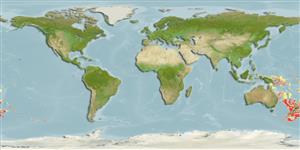Common names from other countries
Цельноголовые (химеры) (chimaeras) >
Chimaeriformes (Chimaeras) >
Chimaeridae (Shortnose chimaeras or ratfishes)
Etymology: Hydrolagus: hydro-, combining form of hydor (Gr.), water; lagos (Gr.), hare, i.e., “water rabbit,” probably referring to three pairs of tooth plates, which tend to protrude from the mouth like a rabbit’s incisors. (See ETYFish); trolli: In honor of American artist Ray Troll (b. 1954), Ketchikan, Alaska (USA), “one of the few true chimaeroid lovers of the world ... for his valiant efforts to increase ratfish awareness worldwide”. (See ETYFish).
Environment: milieu / climate zone / depth range / distribution range
экология
морской батидемерсальный; пределы глубины 612 - 1707 m (Ref. 45071). Deep-water
Western Pacific: New Caledonia and New Zealand.
Size / Вес / Возраст
Maturity: Lm ? range ? - ? cm
Max length : 112 cm TL самец/пол неопределен; (Ref. 45071); 120.4 cm TL (female); наибольший вес (опубликованные данные): 8.8 kg (Ref. 122636)
Краткое описание
определительные ключи | морфология | морфометрия
Body blue-gray with a dark line around the orbit and dark shadowing along edges of lateral-line canals. Snout pointed. Preopercular and oral lateral-line canals sharing a common branch. D1 concave with pale margin. Males with frontal tenaculum deeply curved, upturned distally with spines along dorsal upturned edge. Prepelvic tenacula deeply indented along distal margin. Pelvic claspers with pale fleshy distal lobes, divided distally for 1/3 their length, tips usually extending beyond distal edge of pelvic fins. Ventral caudal fin not deeply indented at its origin to form a separate anal fin.
Oviparous (Ref. 205). Eggs are encased in horny shells (Ref. 205). Reported sexual maturity at 550-65.0 cm BDL or body length (Ref. 116866).
Life cycle and mating behavior
Maturities | размножение | Spawnings | Egg(s) | Fecundities | личинки
Didier, D.A. and B. Séret, 2002. Chimaeroid fishes of New Caledonia with description of a new species of Hydrolagus (Chondrichthyes, Holocephali). Cybium 26(3):225-233. (Ref. 45071)
Статус Красного Списка МСОП (Ref. 130435)
CITES (Ref. 128078)
Not Evaluated
Угроза для людей
Harmless
Использование человеком
дополнительная информация
инструменты
Специальные отчеты
Скачать в формате XML
ресурсы в Интернет
Estimates based on models
Preferred temperature (Ref.
115969): 3.4 - 6.9, mean 4.8 (based on 322 cells).
Phylogenetic diversity index (Ref.
82804): PD
50 = 0.5000 [Uniqueness, from 0.5 = low to 2.0 = high].
Bayesian length-weight: a=0.00282 (0.00118 - 0.00673), b=3.10 (2.89 - 3.31), in cm Total Length, based on LWR estimates for this (Sub)family-body shape (Ref.
93245).
Trophic level (Ref.
69278): 4.0 ±0.6 se; based on size and trophs of closest relatives
устойчивость к внешним воздействиям (Ref.
120179): низкий, минимальное время удвоения популяции 4.5-14 лет (Assuming Fec <100).
Fishing Vulnerability (Ref.
59153): High to very high vulnerability (72 of 100).
